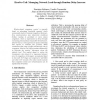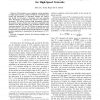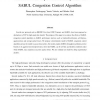90 search results - page 6 / 18 » Congestion Control for Small Buffer High Speed Networks |
NETWORKING
2004
13 years 11 months ago
2004
MaxNet is a distributed congestion control architecture in which only the most severely bottlenecked link on the end-to-end path generates the congestion signal that controls the s...
ISCC
2007
IEEE
14 years 4 months ago
2007
IEEE
Window-based congestion control is typically based on exhausting bandwidth capacity, which occasionally leads to transient congestion. Moreover, flow synchronization may deteriora...
PDPTA
2004
13 years 11 months ago
2004
Standard "new-Reno" TCP faces some performance limitations in very high throughput IP WAN networks, (e.g., computing grids) due to a long end-to-end congestion feedback l...
VALUETOOLS
2006
ACM
14 years 4 months ago
2006
ACM
— We introduce a new congestion control algorithm for high speed networks, called TCP-Illinois. TCP-Illinois uses packet loss information to determine whether the window size sho...
NETWORKING
2004
13 years 11 months ago
2004
Several new protocols such as RBUDP, User-Level UDP, Tsunami, and SABUL, have been proposed as alternatives to TCP for high speed data transfer. The purpose of this paper is to an...



